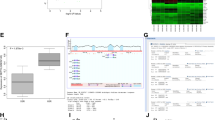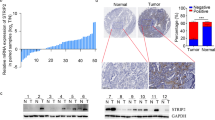Abstract
Special AT-rich sequence-binding protein 2 (SATB2) is a transcription factor, which plays an important role in transcriptional regulation and chromatin recombinant by combining with matrix attachment regions. More evidence shows that SATB2 is involved in progression of breast cancer, head and neck squamous cell carcinomas and osteosarcoma. However, the role of SATB2 in cancer initiation and progression is still not well understood. Our study identified that decreased expression of SATB2 was correlated with tumor progression and poor prognosis in non-small cell lung cancer (NSCLC) patients. Furthermore, SATB2 suppressed lung cancer cell invasion and metastasis and regulated the expression of EMT-related proteins and histone methylation by G9a. In summary, SATB2 may act as a tumor suppressor gene in NSCLC.





Similar content being viewed by others
Abbreviations
- SATB2:
-
Special AT-rich sequence-binding protein 2
- MARs:
-
Matrix attachment regions
- NSCLC:
-
Non-small cell lung cancer
- EMT:
-
Epithelial to mesenchymal transition
- HMT:
-
Histone lysine methyltransferase
- HNSCC:
-
Head and neck squamous cell carcinoma
References
Dobreva G, Dambacher J, Grosschedl R. SUMO modification of a novel MAR-binding protein, SATB2, modulates immunoglobulin mu gene expression. Genes Dev. 2003;17:3048–61.
Cai S, Lee CC, Kohwi-Shigematsu T. SATB1 packages densely looped, transcriptionally active chromatin for coordinated expression of cytokine genes. Nat Genet. 2006;38:1278–88.
Dobreva G, Chahrour M, Dautzenberg M, et al. SATB2 is a multifunctional determinant of craniofacial patterning and osteoblast differentiation. Cell. 2006;125:971–86.
Britanova O, Akopov S, Lukyanov S, et al. Novel transcription factor Satb2 interacts with matrix attachment region DNA elements in a tissue-specific manner and demonstrates cell-type-dependent expression in the developing mouse CNS. Eur J Neurosci. 2005;21:658–68.
Gyorgy AB, Szemes M, de Juan Romero C, et al. SATB2 interacts with chromatin-remodeling molecules in differentiating cortical neurons. Eur J Neurosci. 2008;27:865–73.
Notani D, Gottimukkala KP, Jayani RS, et al. Global regulator SATB1 recruits β-catenin and regulates T(H)2 differentiation in Wnt-dependent manner. PLoS Biol. 2010;8:e1000296.
Britanova O, de Juan Romero C, Cheung A, et al. Satb2 is a postmitotic determinant for upper-layer neuron specification in the neocortex. Neuron. 2008;57(3):378–92.
Zhao X, Qub Z, et al. The role of SATB2 in skeletogenesis and human disease. Cytokine Growth Factor Rev. 2014;25(1):35–44.
Patani N, Jiang W, Mansel R, et al. The mRNA expression of SATB1 and SATB2 in human breast cancer. Cancer Cell Int. 2009;9:18.
Chung J, Lau J, Cheng LS, et al. SATB2 augments DeltaNp63alpha in head and neck squamous cell carcinoma. EMBO Rep. 2010;11(10):777–83.
Wang S, Zhou J, Wang XY, et al. Down-regulated expression of SATB2 is associated with metastasis and poor prognosis in colorectal cancer. J Pathol. 2009;219(1):114–22.
Mansour MA, Asano E, Hyodo T, et al. Special AT-rich sequence-binding protein 2 suppresses invadopodia formation in HCT116 cells via palladin inhibition. Exp Cell Res. 2015;332(1):78–88.
Yang MH, Yu J, Jiang DM, et al. microRNA-182 targets special AT-rich sequence-binding protein 2 to promote colorectal cancer proliferation and metastasis. J Trans Med. 2014;12:109.
Yang MH, Yu J, Chen N, et al. Elevated microRNA-31 expression regulates colorectal cancer progression by repressing its target gene SATB2. PLoS ONE. 2013;8(12):e85353.
Wu L, Chen J, Qin Y, et al. SATB2 suppresses gastric cancer cell proliferation and migration. Tumour Biol. 2016;37(4):4597–602.
Thiery JP, Acloque H, Huang RY, et al. Epithelial-mesenchymal transitions in development and disease. Cell. 2009;139(5):871–90.
Otsuki T, Fujimoto D, Hirono Y, et al. Thrombin conducts epithelial–mesenchymal transition via protease-activated receptor-1 in human gastriccancer. Int J Oncol. 2014;45(6):2287–94.
Wei J, Shi Y, Zheng L, et al. miR-34 s inhibit osteoblast proliferation and differentiation in the mouse by targeting SATB2. J Cell Biol. 2012;197(4):509–21.
Casciello F, Windloch K, Gannon F, et al. Functional role of G9a histone methyltransferase in cancer. Front Immunol. 2015;6:487.
Chen MW, Hua KT, Kao HJ, et al. H3K9 histone methyltransferase G9a promotes lung cancer invasion and metastasis by silencing the cell adhesion molecule Ep-CAM. Cancer Res. 2010;70(20):7830–40.
Huang J, Dorsey J, Chuikov S, et al. G9a and Glp methylate lysine 373 in the tumor suppressor p53. J Biol Chem. 2010;285(13):9636–41.
Zhong X, Chen X, Guan X, et al. Overexpression of G9a and MCM7 in oesophageal squamous cell carcinoma is associated with poor prognosis. Histopathology. 2015;66(2):192–200.
Wozniak RJ, Klimecki WT, Lau SS, et al. 5-Aza-2′-deoxycytidine-mediated reductions in G9A histone methyltransferase and histone H3 K9 di-methylation levels are linked to tumor suppressor gene reactivation. Oncogene. 2007;26(1):77–90.
Poggi A, Giuliani M. Mesenchymal stromal cells can regulate the immune response in the tumor microenvironment. Vaccines Basel. 2016;4(4):41.
Dong C, Wu Y, Yao J, et al. G9a interacts with Snail and is critical for Snail-mediated E-cadherin repression in human breast cancer. J Clin Invest. 2012;122(4):1469–86.
Mansour MA, Hyodo T, Ito S, Kurita K, et al. SATB2 suppresses the progression of colorectal cancer cells via inactivation of MEK5/ERK5 signaling. FEBS J. 2015;282(8):1394–405.
Wu L, Chen J, Qin Y, Mo X, Huang M, Ru H, et al. SATB2 suppresses gastriccancer cell proliferation and migration. Tumour Biol Tumour Biol. 2016;37(4):4597–602.
Seong BK, Lau J, Adderley T, Kee L, et al. SATB2 enhances migration and invasion in osteosarcoma by regulating genes involved in cytoskeletal organization. Oncogene. 2015;34(27):3582–92.
Kucuksayana H, Ozesb ON, Akcaa H. Downregulation of SATB2 is critical for induction of epithelial-to-mesenchymal transition and invasion of NSCLC cells. Lung Cancer. 2016;98:122–9.
Mansour MA, Hyodo T, Akter KA, et al. SATB1 and SATB2 play opposing roles in c-Myc expression and progression of colorectal cancer. Oncotarget. 2016;7(4):4993–5006.
Estève PO, Chin HG, Smallwood A, et al. Direct interaction between DNMT1 and G9a coordinates DNA and histone methylation during replication. Genes Dev. 2006;20(22):3089–103.
Gao J, Aksoy BA, Dogrusoz U, et al. Integrative analysis of complex cancer genomics and clinical profiles using the cBioPortal. Sci Signal. 2013;6(269):l1.
Lehnertz B, Pabst C, Su L, et al. The methyltransferase G9a regulates HoxA9-dependent transcription in AML. Genes Dev. 2014;28(4):317–27.
Hua KT, Wang MY, Chen MW, et al. The H3K9 methyltransferase G9a is a marker of aggressive ovarian cancer that promotes peritoneal metastasis. Mol Cancer. 2014;13:189.
FitzPatrick DR, Carr IM, McLaren L, et al. Identification of SATB2 as the cleft palate gene on 2q32–q33. Hum Mol Genet. 2003;12:2491–501.
Bengani H, Handley M, Alvi M, et al. Clinical and molecular consequences of disease-associated de novo mutations in SATB2. Genet Med. 2017. doi:10.1038/gim.2016.211.
Acknowledgments
We thank Yu-chen Han, Yi-nan Ma and Hai-yan Zhang for their constructive comments and suggestions on the manuscript, Liang-Ru Fei, Mei-Yu Zhang, Cong-Cong Wang and Yuan Luo for technical support. Yinan Ma takes responsibility for the integrity of the article. We also thank National Natural Science Foundation of China (No. 81272605) for supporting this study.
Author information
Authors and Affiliations
Corresponding author
Ethics declarations
Conflict of interest
The authors declare that they have no conflict of interest.
Ethical approval
The study protocol conforms to the ethical guidelines of the World Medical Association, Declaration of Helsinki—Ethical Principles for Medical Research Involving Human Subjects adopted by the 18th WMA General Assembly, Helsinki, Finland, June 1964, and amended by the 64th WMA General Assembly, Fortaleza, Brazil, October 2013, as reflected in a priori approval by the appropriate institutional review committee. The Hospital General Universitario Ethic’s Committee approved the protocol, and all patients gave their informed consent for the inclusion in the study.
Informed consent
Informed consent was obtained from each patient on the day of admission.
Rights and permissions
About this article
Cite this article
Ma, Yn., Zhang, HY., Fei, LR. et al. SATB2 suppresses non-small cell lung cancer invasiveness by G9a. Clin Exp Med 18, 37–44 (2018). https://doi.org/10.1007/s10238-017-0464-3
Received:
Accepted:
Published:
Issue Date:
DOI: https://doi.org/10.1007/s10238-017-0464-3




